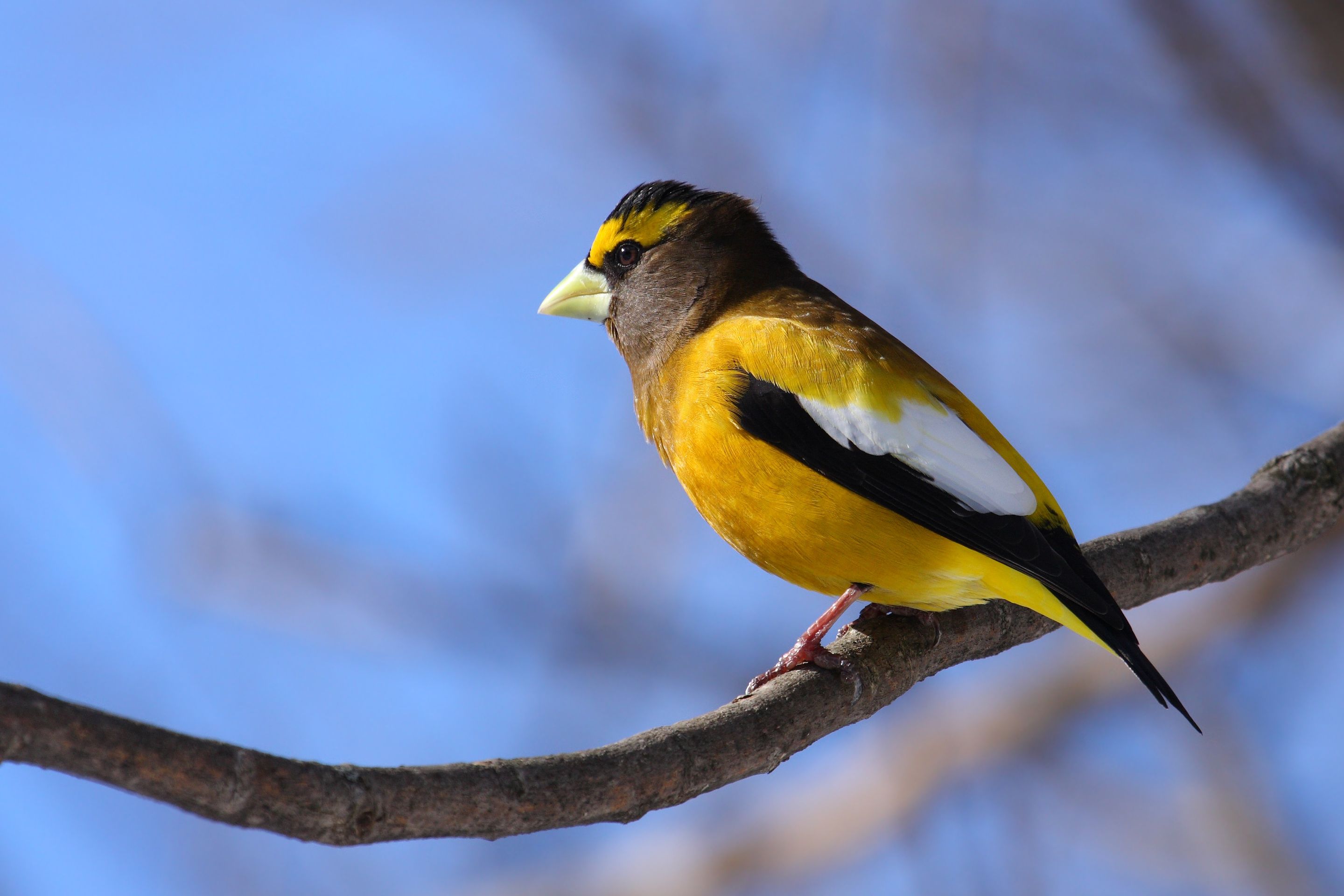 The Evening Grosbeak is an attractive yellow and black heavy-billed finch with a white wing patch most obvious in flight. The scientific name, Hesperiphona vespertinus, means “sound of the evening,” although the idea that they are mainly crepuscular is mistaken. They were apparently first named by French explorers who probably first observed them in the twilight hours. They should actually be called the Morning Grosbeak. They eat mainly seeds, insects, and berries with a bill that can exert over 100 pounds per square inch; a human can exert about 70 pounds per square inch on the back molars and less on the front teeth. These birds can crack cherry and olive pits with their bills! “Grosbeak” comes from the French gros bec, meaning thick beak.
The Evening Grosbeak is an attractive yellow and black heavy-billed finch with a white wing patch most obvious in flight. The scientific name, Hesperiphona vespertinus, means “sound of the evening,” although the idea that they are mainly crepuscular is mistaken. They were apparently first named by French explorers who probably first observed them in the twilight hours. They should actually be called the Morning Grosbeak. They eat mainly seeds, insects, and berries with a bill that can exert over 100 pounds per square inch; a human can exert about 70 pounds per square inch on the back molars and less on the front teeth. These birds can crack cherry and olive pits with their bills! “Grosbeak” comes from the French gros bec, meaning thick beak.
There are seven types of grosbeaks found in North America: Evening, Black-headed, Blue, Crimson-collared, Pine, Rose-breasted, and Yellow. (The Crimson-collared and Yellow Grosbeaks just barely find their way into the southwestern U.S. from Mexico.)
I remember being on Dauphin Island off of Mobile, Alabama one day years ago during spring migration, watching birds as they finished their northward trek across the Gulf of Mexico. About 75 Rose-breasted Grosbeaks landed in a tree near me; it was quite a sight.
On my morning walk the other day I was pleased to see a group of about 40 Evening Grosbeaks fluttering in, around, and under a tree. I used to see them regularly every winter but I haven’t see them in years. Evening Grosbeaks are permanent residents of southern Canada and the western mountains of the U.S. and winter over much of the U.S. Their populations undergo what are known as irruptions in which their populations rapidly rise and fall over a few years, mainly due to the availability of pine seeds on their breeding grounds. Notice that the graph that shows these irruptions, a steady decline in the size of the population is also indicated.
According to Audubon, they are #2 on the list of Common Birds in Decline ,second only to the Northern Bobwhite. Since 1967 the population of the Evening Grosbeak has declined 78%, from 17 million to 3.8 million. Over the last 40 years the average population of the common birds in steepest decline has fallen by 68 percent; some individual species declined 80 percent. All 20 birds on the national list lost at least half their populations in just four decades.
There are several causes for the decline, but global warming is a major factor. Evening Grosbeaks are not wintering as far south and pine trees on the southern edge of their range are disappearing. Global warming and cooling have always been a part of the earth’s climate cycle, but the cycles have happened over approximately 100,000 years. The warming trend we see now has happened over the past 40. Bird populations can adjust over 100,000 years, but not 40. It would be nice if our society had the political will to help the birds (and everything else.)
Thank you for the info. I will appreciate having the evening grosbeaks around even more now. A couple months ago 5 of them showed up at my bird feeders here in Randle, Washington. Soon it was 10, then 20 and now about 30 of them.
Don’t know if you can help, but I tried to take a pic of a bird we have never had here before. The pic was blurry but the bird was a little larger than a stellars jay with a pure white chest, a dark grey head and all grey back. I thought it might be a hawk, but could not find one that looked like this. Any ideas would help.
Thank you,
Linda
Sounds like a Gray Jay. Have a photo?